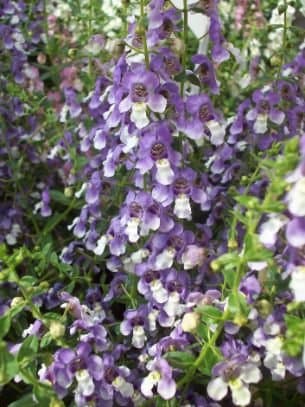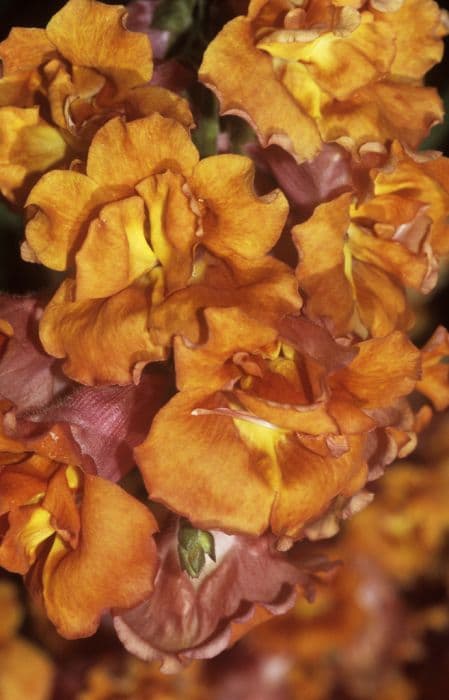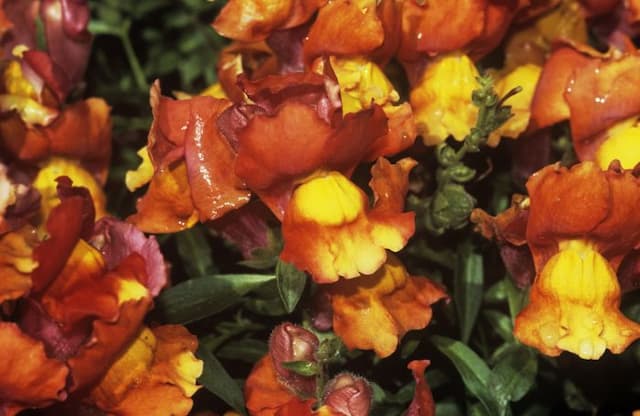Menzies' penstemon Penstemon davidsonii var. menziesii
ABOUT
Penstemon davidsonii var. menziesii, commonly known as Davidson's penstemon or Menzies' penstemon, is an attractive flowering plant often found in mountainous regions. The plant exhibits a mat-forming growth habit, typically spreading outwards with glossy, evergreen leaves. These leaves are small, thick, and can be described as spoon-shaped or somewhat rounded, with a smooth to slightly toothed edge. The flowers of Davidson's penstemon are particularly striking. They are tubular with a slightly flared mouth and come in shades of blue to violet, often with a hint of pink. Each flower is arranged on the stem in a loose cluster, which adds a splash of color to the plant's dense foliage. The stems of Davidson's penstemon are slender but firm, supporting the weight of the leaves and flowers. They sometimes have a reddish tint, which contrasts nicely with the green of the leaves and the colors of the blooms. Overall, the plant presents a lush appearance that makes it a favorite among gardeners and nature enthusiasts for its ornamental value in rock gardens and alpine displays.
About this plant
 Names
NamesFamily
Plantaginaceae
Synonyms
Davidson's Penstemon, Menzies' Beardtongue, Sierra Penstemon, Mountain Blue Penstemon
Common names
Penstemon davidsonii subsp. menziesii, Penstemon menziesii.
 Toxicity
ToxicityTo humans
Menzies' Penstemon is not commonly known as a toxic plant to humans. There are no widely reported cases of poisoning from ingestion of this plant. As such, there are no specific symptoms of poisoning associated with Menzies' Penstemon for humans. However, as with any non-food plant, it is generally advised not to consume it. If you have any concerns after ingesting this plant or any part of it, it is best to consult with a healthcare professional.
To pets
Menzies' Penstemon is not commonly recognized as a toxic plant to pets. There is no significant evidence to suggest that this plant poses a risk of poisoning to pets such as dogs and cats. Therefore, no specific symptoms of toxicity are associated with Menzies' Penstemon for pets. Nonetheless, it's often a good idea to prevent pets from eating ornamental plants, as they can sometimes cause gastrointestinal upset simply due to being non-digestible. If you suspect your pet has consumed Menzies' Penstemon and is showing adverse symptoms, contact your veterinarian for advice.
 Characteristics
CharacteristicsLife cycle
Perennials
Foliage type
Evergreen
Color of leaves
Green
Flower color
Lavender
Height
0-1 feet [0-0.3 meters]
Spread
1-2 feet [0.3-0.6 meters]
Plant type
Herb
Hardiness zones
4
Native area
North America
Benefits
 General Benefits
General Benefits- Attracts Pollinators: Penstemon davidsonii var. menziesii, also known as Menzies' beardtongue, invites bees, butterflies, and hummingbirds, enhancing pollination in the garden.
- Drought Resistance: Once established, Menzies' beardtongue is highly drought-tolerant, making it suitable for xeriscaping and water-wise gardening.
- Erosion Control: Its low-growing, mat-forming habit helps stabilize soil and prevent erosion on slopes and banks.
- Ornamental Value: With its attractive foliage and showy flowers, Menzies' beardtongue is valued for its aesthetic appeal in rockeries and alpine gardens.
- Low Maintenance: It requires minimal care regarding watering, fertilization, and pruning, making it an ideal choice for low-maintenance landscapes.
- Native Habitat Support: As a native plant, it provides natural habitat and food for local wildlife and insects, supporting biodiversity.
- Seasonal Interest: Menzies' beardtongue offers seasonal interest with its blooms typically in late spring to early summer, adding color to the garden when many other plants have not yet started to flower.
 Medical Properties
Medical PropertiesThis plant is not used for medical purposes.
 Air-purifying Qualities
Air-purifying QualitiesThis plant is not specifically known for air purifying qualities.
 Other Uses
Other Uses- Penstemon davidsonii var. menziesii, commonly known as Davidson's Penstemon, can be used as a low-maintenance ground cover in rock gardens due to its mat-forming growth habit.
- Davidson's Penstemon is sometimes used in butterfly gardens as it provides nectar for native pollinators and butterflies during its blooming season.
- The plant's ability to grow in harsh, rocky environments makes it suitable for erosion control in sloped areas or areas prone to soil degradation.
- Due to its vibrant blooms, it is utilized as a natural dye source for fabrics and crafting materials, giving subtle shades of color.
- Davidson's Penstemon can serve as an educational tool in botany and ecology courses, illustrating plant adaptation to alpine conditions.
- In landscape design, the plant's compact and low-growing nature is employed to create texture contrasts with taller, upright plants in garden arrangements.
- Its flowers can be used to make a fragrant, decorative potpourri that can be enjoyed in the home.
- Gardeners sometimes use the dried seed pods in floral arrangements, providing a unique aesthetic due to their shape and texture.
- For hobbyist photographers and artists, Davidson's Penstemon is a popular subject for capturing the beauty of alpine flora in their work.
- The plant's resilience to cold temperatures makes it a candidate for studying the effects of climate change on mountain ecosystems and species survival.
Interesting Facts
 Feng Shui
Feng ShuiThe plant Davidson's Penstemon is not used in Feng Shui practice.
 Zodiac Sign Compitability
Zodiac Sign CompitabilityThe plant Davidson's Penstemon is not used in astrology practice.
 Plant Symbolism
Plant Symbolism- Resilience: Penstemon davidsonii var. menziesii, commonly known as Davidson's Penstemon, often grows in rugged, mountainous terrains and can survive in tough environmental conditions, symbolizing the ability to endure and thrive amidst difficulties.
- Adaptability: As a species that is capable of flourishing in various soil types and altitudes, Davidson's Penstemon represents the quality of adaptability in the face of changing circumstances.
- Beauty in diversity: With its various colors and forms found in different subspecies, Davidson's Penstemon stands for the concept that there is beauty in diversity and variation.
- Attraction: The bright and attractive flowers of Davidson's Penstemon are known to lure pollinators like bees and hummingbirds, making it a symbol of attraction and magnetism in the natural world.
- Balance with nature: Davidson's Penstemon is often used in native gardens to attract wildlife and promote biodiversity, which represents living in balance with nature and supporting ecological harmony.
 Water
WaterMenzies' Beardtongue prefers moderate moisture and should be watered deeply to encourage root growth, about once a week, providing about one gallon of water each time. The frequency should be adjusted based on weather conditions, with less water required during rainy periods and more during dry spells. Always allow the soil to dry out slightly between watering to prevent root rot. Over the growing season, this equates to roughly 4 gallons per month, assuming no significant rainfall.
 Light
LightMenzies' Beardtongue thrives best in full sun to partial shade. Ideally, it should be planted in a location that receives at least six hours of direct sunlight each day. Morning sun with afternoon shade is beneficial, especially in hotter climates, to protect it from the intense late-day sun.
 Temperature
TemperatureThe ideal temperature range for Menzies' Beardtongue is between 60°F and 75°F. It can survive in temperatures as low as 10°F and as high as 90°F. These plants are hardy and adapted to a wide range of temperatures but perform best when extreme highs and lows are avoided.
 Pruning
PruningMenzies' Beardtongue should be pruned to remove spent flower spikes and encourage a second bloom. Pruning is also necessary to maintain the plant's shape and remove any damaged or diseased stems. The best time for pruning is late winter or early spring before new growth begins.
 Cleaning
CleaningAs needed
 Soil
SoilDavidson's Penstemon requires well-draining soil with a mixture of sand, loam, and organic matter. The ideal pH range for this plant is between 6.0 and 7.0 to mimic its native alpine conditions.
 Repotting
RepottingDavidson's Penstemon does not need frequent repotting; it can be repotted every 2-3 years or once it outgrows its current pot.
 Humidity & Misting
Humidity & MistingDavidson's Penstemon thrives in moderate humidity conditions; however, it is tolerant of a range of humidity levels typical of alpine environments.
 Suitable locations
Suitable locationsIndoor
Ensure bright light, cool temps, and good air circulation.
Outdoor
Place in sunny spot, protect from hot midday sun.
Hardiness zone
4-8 USDA
 Life cycle
Life cyclePenstemon davidsonii var. menziesii, commonly known as Davidson's penstemon or Menzies' beardtongue, typically starts its life as a seed that germinates in late spring after experiencing cold stratification through the winter. Upon germination, the seedling establishes a root system and grows into a small rosette of leaves close to the ground. During the following growing season, it develops a more robust root system and begins to produce more leaves, preparing for future flowering. Flowering generally occurs in the late spring or early summer of the second or third year, when the plant produces upright inflorescences with clusters of tubular flowers that are attractive to pollinators like bees and hummingbirds. After pollination and successful fertilization, the plant sets seed in the form of a capsule that eventually opens to release the seeds into the surrounding environment. The parent plant may die after seeding, depending on the environmental conditions and age, but many individuals of this perennial species survive multiple flowering seasons.
 Propogation
PropogationPropogation time
Spring to Summer
Penstemon davidsonii var. menziesii, commonly known as Davidson's penstemon, is best propagated by seed. The most suitable time to sow the seeds is in autumn or early spring, as these seasons provide favorable temperatures for germination. To propagate Davidson's penstemon by seed, one must start by sowing the seeds thinly on the surface of a well-drained seed-starting mix. The seeds require light for germination, so they should not be covered with soil but lightly pressed into the medium. A plastic cover or glass can be used to retain moisture until germination occurs, usually within 2 to 4 weeks. It is important to keep the seedlings moderately moist and to provide bright but indirect light during the initial stages of growth. Once the seedlings are large enough to handle, they can be transplanted into individual pots and eventually planted outside after the danger of frost has passed.









